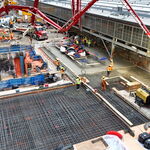It is however kind of astounding that the line is currently only moving 10% of its theoretical capacity at peak.
It is, but it is not..........lets dissect that assertion just a bit...........but let me begin by posting the relevant slide:
Ok............so first off.........where did we get that 30,000 from?
That is Line 1, very optimistically, in rush, with a headway at or below every 2'30 with six-car trains.
Sheppard has been physically set up so that only four car trains can operate (the rest of the station boxes are there, but walled off)}
This is important, because it means if you maxed out Sheppard headway w/o ATC and PEDs you actually have an upper limit o f 20,000 per hour; I would argue for 19,000, and that's at crush-load.
*****
Also important to note is that Sheppard is running peak headway of every 5 min...............
Which means you drop that number by 1/2 again to every 9,500 or so.
*****
But before we get carried away w/theoretical numbers.........
If every 4-car train left the terminal station w/every seat filled, but no standees at every 5' you're actually looking at peak capacity of ~3,400 per hour
Obviously one expects some standees in rush hour, and you have to allow for some churn..........
But the numbers are not as wildly off as they first seem.
I would equally add, there is an artificial cap..........
By which I mean, the actual peak trains on Sheppard are crush-loaded.............w/no room for additional passengers.
This reflects a suppression of real demand.
****
Finally, we come back to the obvious, that a very short line, missing a key intermediate station (Willowdale) will naturally under perform its potential.





